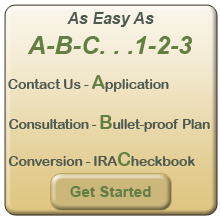By Karin Price Mueller/The Star-Ledger
on February 17, 2014 at 7:23 AM, updated February 17, 2014 at 7:28 AM

Q. I have four IRAs and I am over 70 1/2. I would like to know how to figure out the required minimum distributions (RMDs) for these accounts.
— Not liking the math
A. Not taking the proper RMDs from IRAs can result in penalties, so we’re glad you’re trying to get a handle on what you with withdraw from these accounts.
You are required to take your first RMD no later than April the first of the year after the year you turn 70½, said Bernie Kiely, a certified financial planner and certified public accountant with Kiely Capital Management in Morristown. Or, if you are still working, you can hold off your first RMD until you stop working.
Kiely explains further with this example: Assuming you’re no longer working. If you were born before July 1, you will turn 70 in a calendar year and you will turn 70½ in the same calendar year. In this case, you are required to take your first RMD by April 1 of the next year.
Kiely said he was born in September, so he will turn 70 in a certain calendar year (he wasn’t sharing exactly when). But he won’t turn 70½ until the next calendar year. So according to the rule, he could wait until April 1 of the next calendar year to take his first RMD.
“The problem with waiting is I will be required to take two RMDs in the same year,” he said. “I plan on taking my first RMD in the year I turn 70½. That way I’ll take one RMD in the year I turn 70½ and one RMD the next year.”
For all subsequent years you must take your RMD by Dec. 31 of each year.
Kiely said the formula for your first RMD is based on the total value of all your IRAs on Dec. 31 of the year prior to your distribution. The second part of the formula is the IRS’s Joint and Last Survivor Table, which is available in IRS Publication 590, “Individual Retirement Arrangements (IRAs). Publication 590 also includes handy worksheets to calculate your RMDs, Kiely said.
Table 3 in Publication 590 is for “Unmarried Owners,” “Married Owners Whose Spouses Are Not More Than 10 Years Younger” and “Married Owners Whose Spouses Are Not the Sole Beneficiaries of Their IRAs.”
Table 3 lists the ages from 70 to 115. Kiely said you should use the age that you will turn on your birthday in that calendar year.
“Each age has a factor; for age 70 the factor is 27.4,” he said. “The rules state that you must calculate the RMD for each of your IRAs separately. But, you can take the entire RMD out of any one IRA.”
Kiely said the formula for your RMD is the value of the account on the last day of the prior year divided by the factor (27.4 at age 70). You divide by the factor — it is not a percentage.
“What if you don’t take your RMD at all or you don’t take enough? The penalty is 50 percent of the amount you failed to take! Because the penalty is so big, I generally recommend my clients take the entire RMD in early January so they don’t forget.”
Kiely had one final thought: You are required to take your RMD and pay the tax. You are not required to spend the money.
Our five part Self Directed IRA email series is complete. Get the Things You Need to Know About the Self Directed IRA – Please Share: https://www.getdrip.com/forms/2268282/submissions/new




